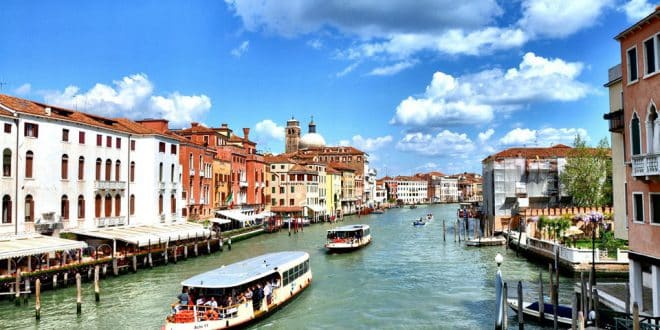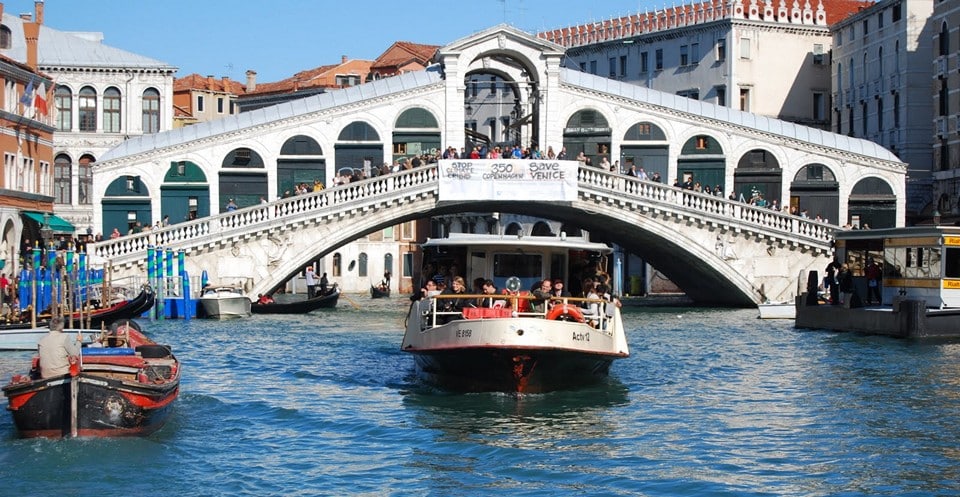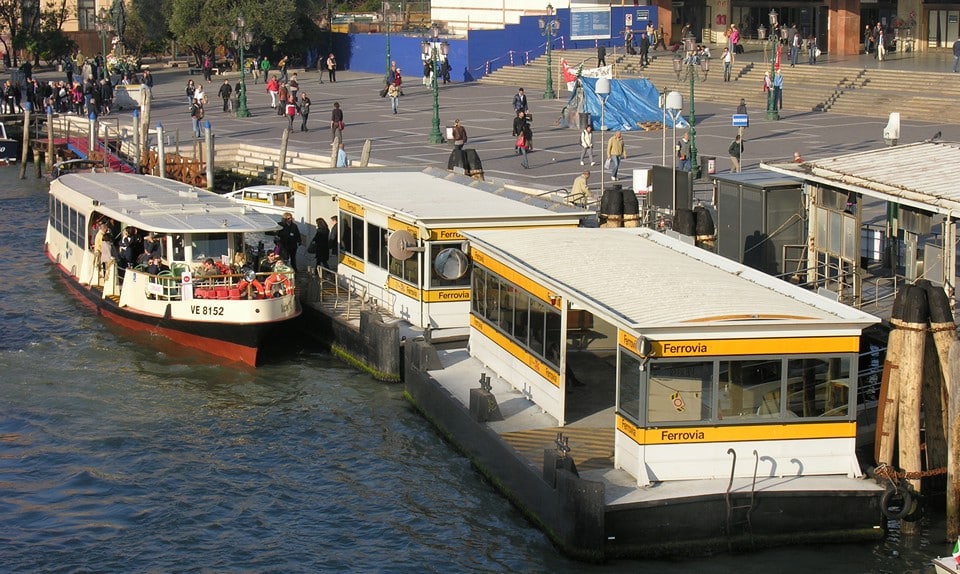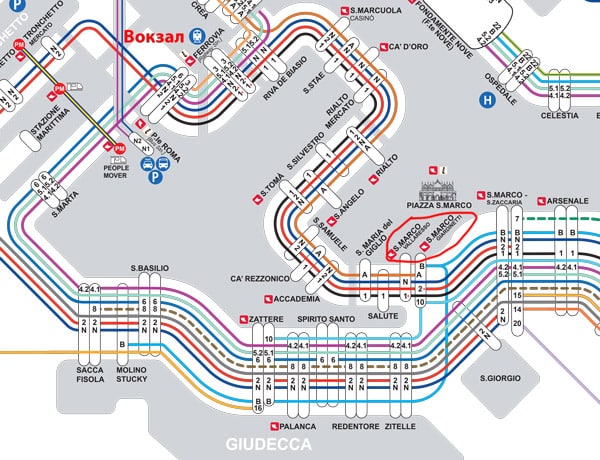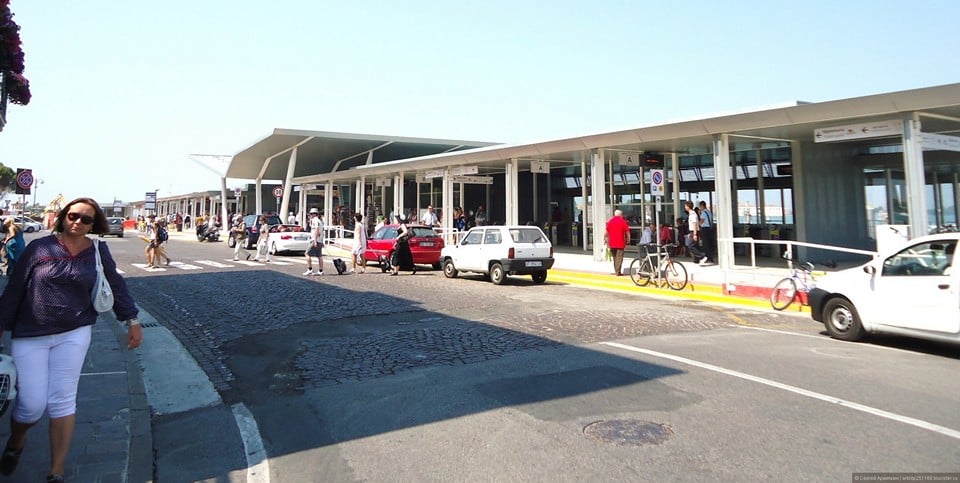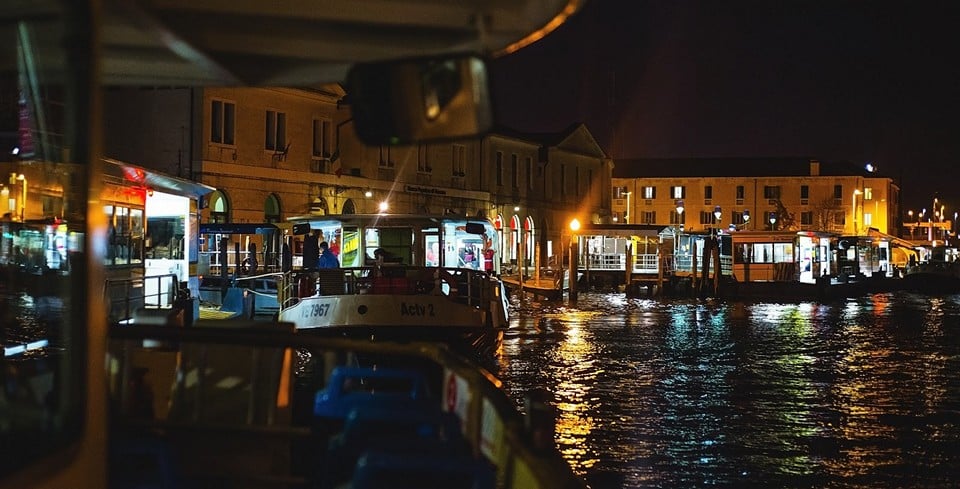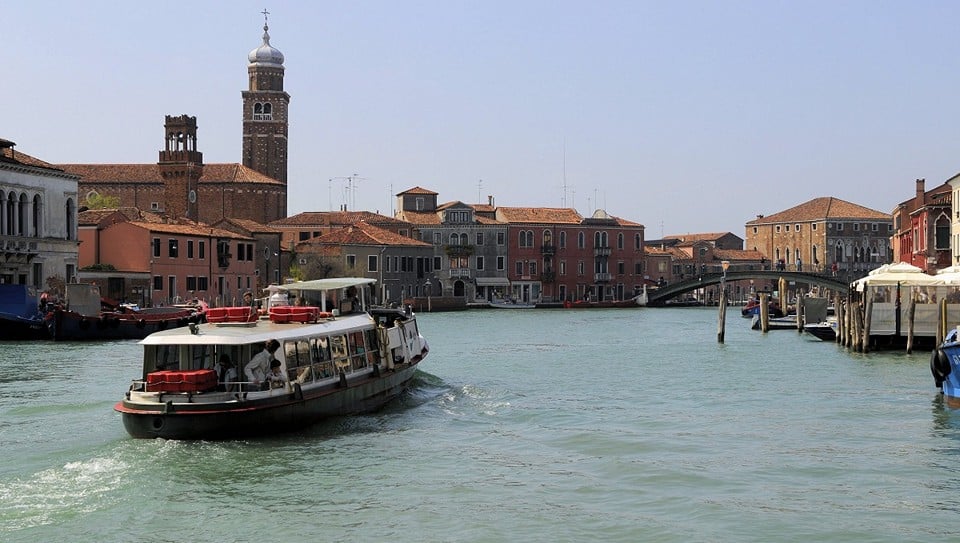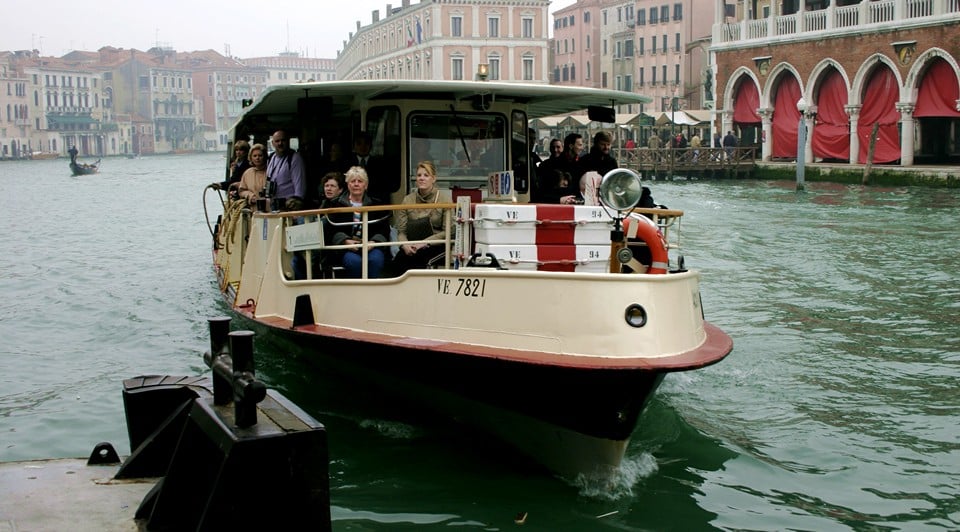Vaporettos, the passenger boats that navigate through the canals of Venice and between the islands of the Venetian archipelago, provide a unique yet convenient mode of public transportation. Let’s explore the characteristics of this transport mode for efficient and cost-effective travel.
Page Contents
River Trams
Essentially, a vaporetto (vaporetto) is akin to a bus or tram, just navigating on water. The operating principles are straightforward: multiple routes with designated stops, water trams run on a set schedule, fares are collected from passengers, and penalties are imposed on fare dodgers. In Italian, ‘Vaporetto’ translates to ‘steamboat’ (from vapor – ‘steam’), though diesel engines power modern vessels. The crew typically consists of a captain and a sailor, announcing stops, mooring the boat, directing passengers at exits, and ensuring safety during boarding and disembarking.
Vaporettos are convenient for traveling through the city’s canals and across the entire archipelago and act as ferries, transporting people from one side of the canal to the other, where bridges do not always connect the two sides.
The first Vaporetto in Venice was introduced in 1881 and quickly gained popularity. Over time, the number of steamboats increased significantly. Today, the ACTV (Azienda Consorzio Trasporti Venezia) company manages the Vaporetto transportation network. Occasionally, they face opposition from gondoliers who have viewed the new transport mode as a threat to their livelihood. These gondoliers occasionally strike and criticize vaporettos for polluting water and air and creating dangerous waves. Their protests have sometimes been successful, evidenced by a recent law limiting vaporettos’ speed to 8 km/h.
Docks
All the docks where Vaporettos stop look the same: a white-painted booth-debarkation point with bright orange stripes.
A large black inscription denotes the name of the stop. Passengers enter and exit via two separate gangways. Inside the debarkation point, there are several zones:
- One area is for passengers waiting for the arrival of the vessel;
- The second is for disembarking passengers;
- The third is for boarding: access here is prohibited if there is no vessel at the dock, when it is docking, or when passengers are disembarking.
There is always a duty officer at each dock who can answer your questions.
Be careful when choosing your direction of travel: at large docks, vessels heading in different directions dock at different places, at smaller ones – in one place. Information signs will help you understand where you need to go.
Types of Vessels
ACTV uses three types of vessels for passenger transportation.
- The Vaporetto itself is a squat vessel with a flat roof and deck; it accommodates an average of 230 people. They mainly operate on the Grand and Cannaregio Canal. Vaporettos differ in height (as some bridges on certain canals are very low), but are generally similar: an enclosed cabin, an open vestibule with a roof, and a few seats at the bow and stern.
- Motoscafi are smaller in size (capacity up to 160 people) but have better seaworthiness, so these vessels serve routes that run through the open water around Venice. They also travel to Murano Island and between small islands with light passenger traffic. Motoscafi resembles large, fully enclosed motorboats.
- Motonavi, as the name suggests, is designed for sea crossings, not narrow canals. They resemble Vaporettos but are much larger and have a higher capacity (up to 600 passengers). These vessels travel to the distant islands of the Lagoon, such as Burano Island. Some motonavi have a high bridge and two decks.
Routes
Venice and its islands have more than 25 Vaporetto routes. Many of them are circular. There are express routes, one night route, and in 2012, a sightseeing tourist route was introduced; it starts every 30 minutes.
Routes 1, 2 (express), N (night), and the tourist route operate along the Grand Canal. Route 1 can also be considered a sightseeing route as it is quite long, with many stops, and allows for a comprehensive impression of the island part of Venice.
Routes 3, 4, and 5 (all express) connect the center of Venice, the island of Murano, the railway station, and the bus station. To reach Murano, Lido, and other islands of the Venetian Lagoon, use routes 13, 20, LN (north lagoon route), and DM (direct express to Murano). All routes are available on the carrier’s website, where you can also find the exact timetable for the water trams.
- To download the route map in PDF, click here
Main Lines
The most popular routes run along the Grand Canal, from the railway station through Piazzale Roma and Piazza San Marco (St. Mark’s Square). Travel time: 45 minutes (Route 1) and 25 minutes (Route 2; stops only in crowded areas).
- Route 1 goes to Lido Island, while Route 2 heads to Giudecca Island; to Lido on this route is only possible during the high season.
- Route 3 serves Murano, connecting the island with Venice’s stations. Use this route to avoid the crowded Grand Canal; it’s a much quicker way to reach your destination.
- Routes 4.1 and 4.2 run in a loop; the first clockwise, the second counter-clockwise. Both start and end on Murano Island.
Other Island Lines
Routes 12 and 14 are suitable for those who want to visit San Michele Island Cemetery or relax on the beaches of Lido. For the former, take Route 12, starting at Fondamente Nova and passing through the larger islands of Burano and Torcello. The total journey takes about 50 minutes. To reach the starting point, Fondamente Nova, you can walk or take Routes 4 or 5.
Route 14 takes you to the beaches of Lido and further. If you’re not a fan of organized beach activities, don’t get off at Lido but continue to Punta Sabbioni, where a large camping site is located.
Night Line
Only one vaporetto line operates at night, running from San Marco to Lido. This route is marked with the letter N. It starts service at 23:20, with the last water tram arriving at its final destination at 5:27. Departures are approximately every half hour and after 1:00, hourly. This is a lengthy and complex route; studying it carefully beforehand is advisable.
Schedule
Almost all stops have information boards displaying upcoming departures and wait times. The intervals between departures vary – on main routes, like Route 1, the waiting time is about 10 minutes. On other lines, the wait might be longer – up to 30 minutes. Intervals may change during the day, in the morning, and in the evening. Schedule changes can also occur due to weather conditions (fog, poor visibility, etc.). A map of routes and the current schedule is available at each stop, and you can ask the attendant for assistance if needed.
The average speed of the Vaporetto is no more than 8 km/h, and they don’t travel on narrow canals, so sometimes it’s more convenient to reach your destination on foot.
Cost
Vaporetto rides are not cheap. It is arguably one of the most expensive types of urban public transport in the world: a single trip costs 9.5 euros. water taxis and gondolas are even more expensive. Moreover, knowing a few tips for using the route boats can help you save money.
If you plan to stay in Venice longer, it’s better to immediately buy so-called tourist transport cards, or passes for several days. This makes staying on the islands and moving around them much cheaper. You can buy a card for 1, 2, 3 days or a week; it costs 20, 30, 40, and 60 euros respectively and includes travel on river trams and regular buses.
- Important: a daily ticket is valid for exactly 24 hours from its first validation. For example, if you validate your ticket on September 10 at 09:00, you can use the Vaporetto until 9 am on September 11 without limitations.
The most cost-effective option is the 3-day ticket for 28 euros, but it’s available only for children and youth aged 6 to 29 years. It costs 6 euros but also offers additional discounts in shopping centers and museums in Venice.
Children under 6 travel on the Vaporetto for free. Travel is also free for disabled people who use wheelchairs and their accompanying persons. A fee of 1.5 euros is charged for the wheelchair itself.
Important: The above is true for all routes except 16, 19, and Alilaguna. The latter operates a boat to and from Marco Polo Airport. Route 16 directly connects Fusina (Fusina, a camping area in Mestre, the mainland part of Venice) and the Fondamenta delle Zattere pier, while route 19 boats travel from San Marco to the island of Chioggia (Chioggia).
- Recommended reading: how to get from Treviso Airport
How and Where to Buy Tickets
Tickets can be purchased at piers, in ACTV vending machines and ticket offices, as well as in tobacco and newspaper kiosks. Tickets can also be bought on board (including when there is no ticket office or vending machine at the pier) – but only single-trip tickets. In most cases, payment can be made in cash and by credit card.
- To save time, it’s advised to plan your stay in Venice by ordering tickets online in advance.
After booking, you will receive a QR and PNR code. Upon arrival at Santa Maria Lucia station, you do not queue at the ticket offices but go to the vending machine on the pier, here is the map point. There you enter your code and get the ticket. The ticket can be activated on any day. Luggage is included in the price.
Children under 6 travel for free.
For example, if you buy a 48-hour ticket in advance and activate it on October 10 at 11:00, it will be valid until October 12 at 10:59. The extra charge for such booking and time-saving is only 3 euros.
Interestingly, Venice residents pay much less for using the river trams, but discounted tickets can only be purchased upon presenting the appropriate document.
Rules and Tips
Purchasing tickets is mandatory. Regular checks are conducted, and fines are substantial: you will have to pay not only for the ride but also a 60 euro administrative penalty. It’s allowed to carry a folded baby stroller, one standard-sized piece of luggage (no more than 150 cm in total dimensions), and two pieces of hand luggage (no longer than 120 cm each). Anything beyond these limits is subject to an additional fee.
Purchased tickets must be activated by holding them to the validator until a sound signal is heard. This needs to be done at each pier; if you didn’t activate your ticket when boarding, you could be fined. Keep your ticket until the end of the journey. You do not need to show the ticket to the sailor when boarding the vessel.
Boarding is only allowed after all passengers have disembarked; until then, access to the boarding area is strictly prohibited. You must strictly follow the instructions of the sailor. Special extendable platforms are available for passengers with limited mobility to help board the vessel.
The best viewing spots are at the bow or stern. These are limited, so it’s better to board the river tram at the starting stops to have a better chance of securing a desired spot. Remember, the vaporetto’s indoor areas are the only fully wind- and rain-protected spots. If you’re sitting in the open areas, only the roof protects you from bad weather, and not always effectively.
Toilets are not available on all vaporettos; they are usually found on vessels operating on extended routes.
The vaporetto is not a tourist river tram but a standard mode of public transportation, so expect it to be crowded during peak hours with both seated and standing passengers. Remember this and prepare for your exit in advance to avoid missing your stop.
Smoking is prohibited not only on the vaporetto but also on the pier.
Be vigilant about your surroundings, and keep valuables and money out of sight and in secure places, as Venice, like any famous tourist city, has its share of pickpockets.
 Italy for me From Italy with love
Italy for me From Italy with love

